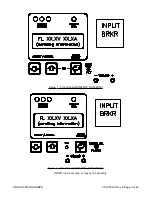
There is no delay when the unit is returning to operation after a remote shutdown signal removal.
The count can be aborted locally by depressing the Enter key (local entry of equalize is inhibited
during delay start). The count can also be remotely by toggling the remote shutdown control signal.
3.3.20
Soft Start
To eliminate an instantaneous demand on the a supply upon application of A.C. power, the units
employ a soft start feature. This feature is sometimes referred to a “current walk-in”. The output of
the Module is gradually ramped up from zero amps to the load requirement (110% max). This
ramping is accomplished by current limiting the output . The circuit ramps at a rate of 8 - 12% per
second. SS will be displayed by the output current on the LCD display during the condition.
3.3.21
Slope or Forced Paralleling
RSM Modules use “output slope” or “forced” paralleling to accomplish load sharing. Forced sharing
is selected in the submenu ADJUSTMENTS. Forced sharing automatically parallels modules in a
shelf via a voting scheme between the modules.
When the Modules are run in parallel with a non RSM unit, slope paralleling is best suited. In slope
adjust method it is necessary to adjust the units to track to each other or share the load over the
output current range of the units. Output slope adjustment alters the regulation curve of the Module.
The output slope is set by the setting found in the submenu ADJUSTMENTS which adjusts the
regulation of the Module beyond its preset factory setting of 0.1% The level is protected by fail safe
circuitry in the unlikely event of micro-controller failure.
3.3.22
Input / Output Circuit Breakers
Every unit is equipped with thermal-magnetic input circuit breaker and a magnetic output circuit
breaker. Excessive current passing through the breaker will result in the breaker releasing to the
tripped (reset) position. The breakers must be manually reset to turn the unit back on. Both break-
ers allow the operator to isolate the unit from either the input or output.
3.3.23
A.C. High / Low Voltage Shutdown
The unit is electronically protected from low voltages to the input by fault detection circuitry. If the
input to the Module falls below the lower A.C. input limit (see specifications), the unit will shutdown.
The minor alarm indicator Module Fail, & relays will turn on, the messages AC MAINS FAIL &
MODULE FAIL
will be display on the LCD panel. If the input to the Module rises above the upper
A.C. input limit (see specifications), the unit will shutdown. The minor alarm indicator Module fail in-
dicator, & relays will turn on, the message AC MAINS HI, & MODULE FAIL will be displayed on the
LCD panel. The unit will resume normal operation immediately upon restoration of normal line con-
ditions. If a start delay is programmed the unit will enter delay when the input is returning from a
low A.C. mains condition. The delay timer is inhibited if the module is returning from a A.C. mains
high condition.
3.3.24
Demand Based Forced Cooling
Cooling of the unit is achieved via front to back forced cooling. Cool air is drawn in via the grill in
the front of the unit. The airflow is directed towards the rear of the unit and over the heat sinks. The
fan speed is based on the internal ambient temperature and the output load of the unit. The speed
control decision is made every five seconds to minimize oscillations of the fan speed.
In the event that the fan fails, the current limit setting of the rectifier will be decreased by an amount
that is dependent on the heat sink temperature. If the temperature sensor fails at the same time as
the fan, then the current limit will be set to 50% of maximum rated current.
ARGUS TECHNOLOGIES
010-030-C0 Rev E Page 11 of 42
















































